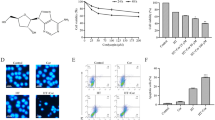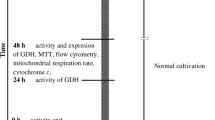Abstract
The aim of this study was to examine whether, a new synthesized class of benzocycloalkene derivatives (BCs), enhances apoptosis induced by hyperthermia. The combined effects of hyperthermia (44°C, 20 min) and BCs on apoptosis in human lymphoma U937 cells were investigated. Among the tested compounds (BC1 ∼ 9), the combined treatment of 10 μM BC2 or BC4 and hyperthermia showed the largest potency to induce DNA fragmentation at 6 h after hyperthermia. And enhancement of hyperthermia-induced apoptosis by BC2 or BC4 in a dose-dependent manner was observed. When the cells were treated first with BC2 or BC4 at a nontoxic concentration of 20 μM, and exposed to hyperthermia afterwards, a significant enhancement of heat-induced apoptosis was evidenced by DNA fragmentation, morphological changes and phosphatidylserine externalization. Flow cytometry revealed an increase of intracellular superoxide due to BC2 or BC4, which was further increased when hyperthermia was combined. Mitochondrial membrane potential was decreased and the activation of caspase-3 and caspase-8 was enhanced in the cells treated with the combination. The activation of Bid, but no change of Bax and Bcl-2 were observed after the combined treatment. The release of cytochrome c from mitochondria to cytosol, which was induced by hyperthermia, was enhanced by BC2 or BC4. An increase in the intracellular Ca2+ concentration [Ca2+]i, externalization of Fas, and decrease in Hsp70 were observed following the combined treatment. These results indicate that the intracellular superoxide generated by BC2 or BC4 is involved in the enhancement of apoptosis through Fas-mitochondria caspase and [Ca2+]i-dependent pathways, and a decrease in Hsp70 also contributed to the enhancement of apoptosis.











Similar content being viewed by others
References
Dahl O, Mella O (2002) Referee: hyperthermia alone or combined with cisplatin in addition to radiotherapy for advanced uterine cervical cancer. Int J Hyperthermia 18:25–30
Prosnitz L, Jones E (2002) Counterpoint: test the value of hyperthermia in patients with carcinoma of the cervix being treated with concurrent chemotherapy and radiation. Int J Hyperthermia 18:13–18
Urano M, Kuroda M, Nishimura Y (1999) For the clinical application of thermochemotherapy given at mild temperatures. Int J Hyperthermia 15:79–107
Raff MC (1992) Social controls on cell survival and cell death. Nature 356:397–400
Arai Y, Kondo T, Tanabe K et al (2002) Enhancement of hyperthermia-induced apoptosis by local anesthetics on human histiocytic lymphoma U937 cells. J Biol Chem 277:18986–18993
Cui ZG, Kondo T, Matsumoto H (2006) Enhancement of apoptosis by nitric oxide released from alpha-phenyl-tert-butyl nitrone under hyperthermic conditions. J Cell Physiol 206:468–476
Li FJ, Kondo T, Zhao QL et al (2003) A lipophilic free radical initiator, 2,2′-azobis (2,4-dimethylvaleronitrile) (AMVN) enhances caspase-dependent apoptosis induced by hyperthermia. Int J Hyperthermia 19:165–177
Zhao QL, Fujiwara Y, Kondo T (2006) Mechanism of cell death induction by nitroxide and hyperthermia. Free Radic Biol Med 40:1131–1143
Li FJ, Kondo T, Zhao QL et al (2001) Enhancement of hyperthermia-induced apoptosis by a free radical initiator, 2,2′-azobis (2-amidinopropane) dihydrochloride, in human histiocytic lymphoma U937 cells. Free Radic Res 35:281–299
Wada S, Cui ZG, Kondo T et al (2005) A hydrogen peroxide-generating agent, 6-formylpterin, enhances heat-induced apoptosis. Int J Hyperthermia 21:231–246
Katschinski DM, Boos K, Schindler SG, Fandrey J (2000) Pivotal role of reactive oxygen species as intracellular mediators of hyperthermia-induced apoptosis. J Biol Chem 275:21094–21098
Matsuya Y, Masuda S, Itoh T, Murai T, Nemoto H (2005) A practical asymmetric synthesis of trans-4,5-benzhydrindan-1-ones as a precursor of A-nor B-aromatic steroidal compounds. J Org Chem 70:6898–6903
Matsuya Y, Ohsawa N, Nemoto H (2006) Accelerated electrocyclic ring-opening of benzocyclobutenes under the influence of a β-silicon atom. J Am Chem Soc 128:412–413
Matsuya Y, Ohsawa N, Nemoto H (2006) Facile transformation of benzocyclobutenones into 2,3-benzodiazepines via 4π–8πi tandem electrocyclic reactions involving net insertion of diazomethylene compounds. J Am Chem Soc 128:13072–13073
Matsuya Y, Sasaki K, Nagaoka M et al (2004) Synthesis of a new class of furan-fused tetracyclic compounds using o-quinodimethane chemistry and investigation of their antiviral activity. J Org Chem 69:7989–7993
Matsuya Y, Sasaki K, Ochiai H, Nemoto H (2007) Synthesis and biological evaluation of dihydrofuran-fused perhydrophenanthrenes as a new anti-influenza agent having novel structural characteristic. Bioorg Med Chem 15:424–432
Yu DY, Matsuya Y, Zhao QL et al (2007) Enhancement of hyperthermia-induced apoptosis by a new synthesized class of furan-fused tetracyclic compounds. Apoptosis 12:1523–1532
Sadana AK, Saini RK, Billups WE (2003) Cyclobutarenes and related compounds. Chem Rev 103:1539–1602
Nemoto H, Peng X, zhong W, **e J, kawamura T, Nishida M (2005) A method for the synthesis of 3a-aryl-substituted cyclopenta[1,2-b]furan derivatives. Synlett 20:3103–3106
Sellins KS, Cohen JJ (1987) Gene induction by gamma-irradiation leads to DNA fragmentation in lymphocytes. J Immunol 139:3199–3206
Hopcia KL, McCarey YL, Sylvester FC, Held KD (1996) Radiation-induced apoptosis in HL60 cells: oxygen effect, relationship between apoptosis and loss of clonogenicity, and dependence of time to apoptosis on radiation dose. Radiat Res 145:315–323
Zhao QL, Kondo T, Noda A, Fujiwara Y (1999) Mitochondrial and intracellular free-calcium regulation of radiation-induced apoptosis in human leukemic cells. Int J Radiat Biol 75:493–504
van Heerde WL, de Groot PG, Reutelingsperger CP (1995) The complexity of the phospholipid binding protein Annexin V. Thromb Haemost 73:172–179
Datta R, Kojima H, Yoshida K, Kufe D (1997) Caspase-3-mediated cleavage of protein kinase C theta in induction of apoptosis. J Biol Chem 272:20317–20320
Cui ZG, Kondo T, Ogawa R et al (2004) Enhancement of radiation-induced apoptosis by 6-formylpterin. Free Radic Res 38:363–373
Gorman A, McGowan A, Cotter TG (1997) Role of peroxide and superoxide anion during tumour cell apoptosis. FEBS Lett 404:27–33
Yuki H, Kondo T, Zhao QL et al (2003) A free radical initiator, 2,2′-azobis (2-aminopropane) dihydrochloride enhances hyperthermia-induced apoptosis in human uterine cervical cancer cell lines. Free Radic Res 37:631–643
Salganik RI (2001) The benefits and hazards of antioxidants: controlling apoptosis and other protective mechanisms in cancer patients and the human population. J Am Coll Nutr 20:464S–472S; discussion 473S–475S
Shackelford RE, Kaufmann WK, Paules RS (2000) Oxidative stress and cell cycle checkpoint function. Free Radic Biol Med 28:1387–1404
Nunez G, Benedict MA, Hu Y, Inohara N (1998) Caspases: the proteases of the apoptotic pathway. Oncogene 17:3237–3245
Tsujimoto Y, Shimizu S (2000) Bcl-2 family: life-or-death switch. FEBS Lett 466:6–10
Eguchi Y, Shimizu S, Tsujimoto Y (1997) Intracellular ATP levels determine cell death fate by apoptosis or necrosis. Cancer Res 57:1835–1840
Eguchi Y, Srinivasan A, Tomaselli KJ, Shimizu S, Tsujimoto Y (1999) ATP-dependent steps in apoptotic signal transduction. Cancer Res 59:2174–2181
Beere HM, Wolf BB, Cain K et al (2000) Heat-shock protein 70 inhibits apoptosis by preventing recruitment of procaspase-9 to the Apaf-1 apoptosome. Nat Cell Biol 2:469–475
Saleh A, Srinivasula SM, Balkir L, Robbins PD, Alnemri ES (2000) Negative regulation of the Apaf-1 apoptosome by Hsp70. Nat Cell Biol 2:476–483
Li M, Kondo T, Zhao QL et al (2000) Apoptosis induced by cadmium in human lymphoma U937 cells through Ca2+-calpain and caspase-mitochondria-dependent pathways. J Biol Chem 275:39702–39709
Nemoto H, Fukumoto K (1998) Second generation of steroid synthesis via o-quinodimethane. Tetrahedron 54:5425–5464
Davidson JF, Whyte B, Bissinger PH, Schiestl RH (1996) Oxidative stress is involved in heat-induced cell death in Saccharomyces cerevisiae. Proc Natl Acad Sci USA 93:5116–5121
Flanagan SW, Moseley PL, Buettner GR (1998) Increased flux of free radicals in cells subjected to hyperthermia: detection by electron paramagnetic resonance spin trap**. FEBS Lett 431:285–286
Frank J, Kelleher DK, Pompella A, Thews O, Biesalski HK, Vaupel P (1998) Enhancement of oxidative cell injury and antitumor effects of localized 44 degrees C hyperthermia upon combination with respiratory hyperoxia and xanthine oxidase. Cancer Res 58:2693–2698
Yoshikawa T, Kokura S, Tainaka K et al (1993) The role of active oxygen species and lipid peroxidation in the antitumor effect of hyperthermia. Cancer Res 53:2326–2329
Skibba JL, Quebbeman EJ, Kalbfleisch JH (1986) Nitrogen metabolism and lipid peroxidation during hyperthermic perfusion of human livers with cancer. Cancer Res 46:6000–6003
Green DR (2000) Apoptotic pathways: paper wraps stone blunts scissors. Cell 102:1–4
Wang X (2001) The expanding role of mitochondria in apoptosis. Genes Dev 15:2922–2933
Cartee L, Sankala H, Davis C et al (2002) 7-hydroxystaurosporine (UCN-01) and ionizing radiation combine to inhibit the growth of Bcl-2-overexpressing U937 leukemia cells through a non-apoptotic mechanism. Int J Oncol 21:351–359
Esposti MD (2002) The roles of Bid. Apoptosis 7:433–440
Li H, Zhu H, Xu CJ, Yuan J (1998) Cleavage of BID by caspase 8 mediates the mitochondrial damage in the Fas pathway of apoptosis. Cell 94:491–501
Nitobe J, Yamaguchi S, Okuyama M et al (2003) Reactive oxygen species regulate FLICE inhibitory protein (FLIP) and susceptibility to Fas-mediated apoptosis in cardiac myocytes. Cardiovasc Res 57:119–128
Strasser A, Newton K (1999) FADD/MORT1, a signal transducer that can promote cell death or cell growth. Int J Biochem Cell Biol 31:533–537
Yin XM (2000) Signal transduction mediated by Bid, a pro-death Bcl-2 family proteins, connects the death receptor and mitochondria apoptosis pathways. Cell Res 10:161–167
Schett G, Steiner CW, Groger M et al (1999) Activation of Fas inhibits heat-induced activation of HSF1 and up-regulation of hsp70. Faseb J 13:833–842
Macho A, Hirsch T, Marzo I et al (1997) Glutathione depletion is an early and calcium elevation is a late event of thymocyte apoptosis. J Immunol 158:4612–4619
Costantini P, Chernyak BV, Petronilli V, Bernardi P (1996) Modulation of the mitochondrial permeability transition pore by pyridine nucleotides and dithiol oxidation at two separate sites. J Biol Chem 271:6746–6751
Nicotera P, Bellomo G, Orrenius S (1992) Calcium-mediated mechanisms in chemically induced cell death. Annu Rev Pharmacol Toxicol 32:449–470
Author information
Authors and Affiliations
Corresponding author
Rights and permissions
About this article
Cite this article
Yu, DY., Matsuya, Y., Zhao, QL. et al. Enhancement of hyperthermia-induced apoptosis by a new synthesized class of benzocycloalkene compounds. Apoptosis 13, 448–461 (2008). https://doi.org/10.1007/s10495-008-0178-9
Published:
Issue Date:
DOI: https://doi.org/10.1007/s10495-008-0178-9




